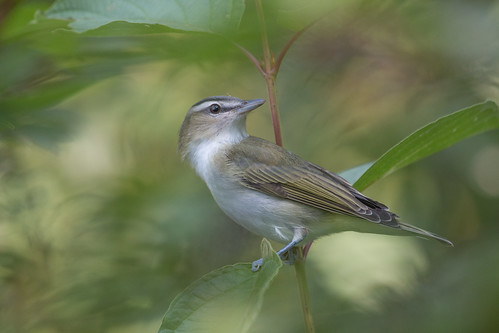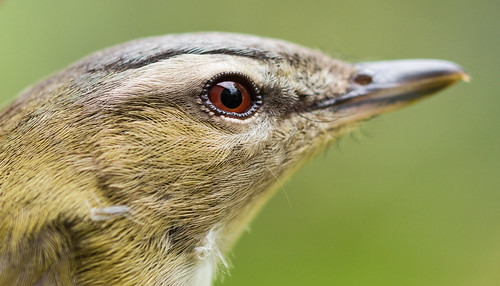Scarlett O’Hara in Gone with the Wind; Miss Elizabeth Bennett in Pride and Prejudice; Anne Shirley of Anne of Green Gables.
Literature is filled with stories of women who spent years in friendly or not-so-friendly relationships with a man before suddenly realizing that they were actually deeply in love with him. In a very little way, I’ve experienced that same scenario in my own life. Not with a man, of course—I’ve been in love with my husband pretty much since our high school freshman registration day—but with a bird.
No species could supplant the chickadee in my heart, but this fall, I suddenly realized I was head over heels with an extremely common, not-very-colorful bird that I’d seen or heard, at least subconsciously, on probably a majority of my late spring and summer days since I started birding in 1975, and probably throughout my childhood as well—the Red-eyed Vireo.
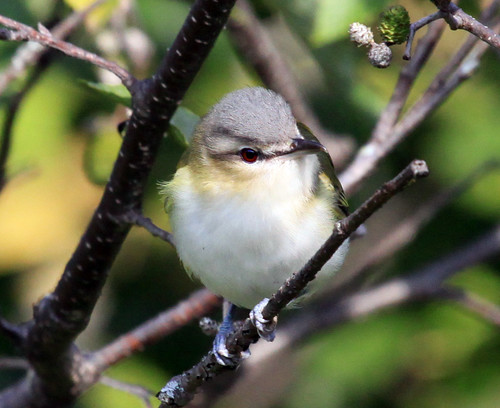 |
Red-eyed Vireos live in pretty much the same habitat as Black-capped Chickadees, but being Neotropical migrants that winter all the way down in the Amazon Basin east of the Andes in South America, they don’t need to compete for scarce resources during frigid northern winters, so the vireos can considerably outnumber chickadees. Black-capped Chickadees are estimated to number about 19 million in the United States—only about 2/5 the number of Red-eyed Vireos here. Of course, Black-capped Chickadees don’t nest in the southeastern states where they’re supplanted by Carolina Chickadees, but even in Canada, where the chickadee range is slightly more extensive than the vireo range, the Red-eyed Vireo population is four times that of the chickadees. The vireos simply just know when to get out of Dodge each year.
Pretty much wherever there are forests in North America, except in a swath of the West, Red-eyed Vireos are common, and were even more abundant when I was a little girl. I grew up within the heart of their range, but had been alive for more than 23 years before I learned of their existence, and a few months older than that before I finally saw one, on June 30, 1975, when I was taking a field ornithology class at the Kellogg Biological Station outside Kalamazoo, Michigan.
As I recall, we heard the song on a few class field trips before we actually saw one. Red-eyed Vireos are persistent singers, and are not particularly shy around people, but they are very deliberate in their movements and blend in with foliage, so seldom catch our eye unless we’re specifically searching for one. And in order to specifically search for one, we must first realize that they exist.
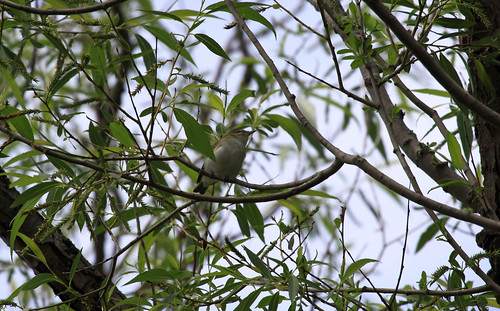 |
| Well, yeah--this is how Red-eyed Vireos usually look, if you don't stop to follow them for a while. |
The Red-eyed Vireo’s song was easy to learn—it produces robin-like phrases, pausing between each, and is one of the few birds that sing persistently in the afternoon as well as early in the morning. By the next spring, with so much more experience at listening and looking, I got good at picking out Red-eyed Vireos in the trees. But right as they were arriving, a rainbow of far more brilliant warblers was also showing up. The vireos were very easy to take for granted.
The first time I took special notice of Red-eyed Vireos was in the late 1980s when I was a wildlife rehabber; at the end of June, a woman brought me four nestlings. She had “rescued” them after a storm over a week before. She fed them nothing but canned dog food, which got smeared all over their faces, heads, and bodies—one chick's eye was entirely covered up—and she never even tried to clean them, so when I got them, their bodies were encased in dried, crusted dog food as immobilizing as a plaster cast, which had stunted the growth of their heads and bodies at the very time during their development when they should have been growing rapidly. The tiny hook at the tip of the bill told me they were vireos, but it took hours of painstaking bathing to get their feathers cleaned up enough to figure out which species.
I gave them a very nutritious diet and a lot of attention, but the poor things didn’t have a chance. The woman told me when she dropped them off that she knew they were doomed from the start, but wanted her children to “appreciate the miracle of baby birds.” She spared her kids the ordeal of watching those miraculous baby birds die, reserving that for my children and me. For a long time, the very thought of Red-eyed Vireos brought that horrible woman to mind. Small wonder the species was not on my favorites list, though obviously through no fault of its own.
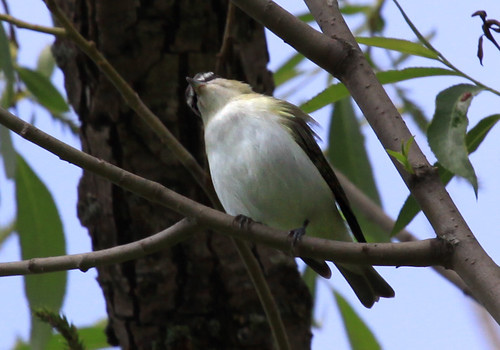 |
Bird banders told me that when they empty their nets, they can never, ever place a vireo in the same bag with any other bird—within minutes, the other bird will be dead. The hook on a vireo’s bill is every bit as lethal a weapon as the similar hook on a shrike’s bill. Small wonder that vireos and shrikes are placed next to each other in current taxonomic systems.
So I was as prejudiced against Red-eyed Vireos as ever Miss Elizabeth Bennett was against Mr. Darcy. But as I said at the start, I ended up falling in love with this avian Mr. Darcy in spite of myself. How on earth did that ever come about?
When I worked full time as science editor at the Cornell Lab of Ornithology, I finally had a bit of discretionary income, and in 2009, bought a digital camera and long lens. Ever since then, I've gone a little nuts taking pictures of birds.
That fall, Russ and I took a little walk on the Western Waterfront Trail in Duluth, and a shockingly cooperative Red-eyed Vireo came out and posed for me, giving me some of the best photos of any bird that I'd ever taken. The best picture of all showed every important feature of the bird in perfect light. Never before had I really noticed just how handsome they are.
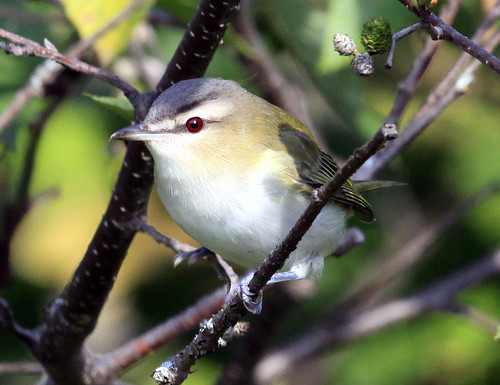 |
 |
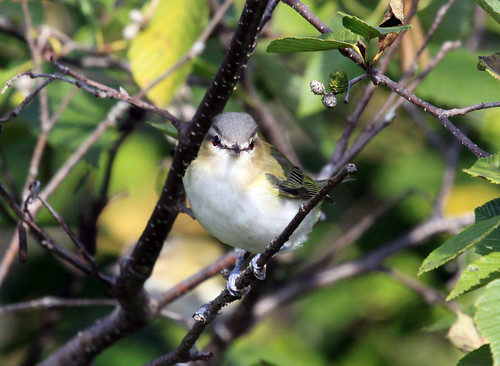 |
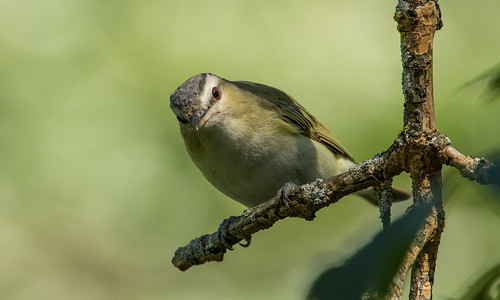 |
 |
Somehow it's hard not to take an interest in any animal that takes a particular interest in you, or at least notices your existence. I don't know if it's a matter of making eye contact or what, but soon I was reading more about Red-eyed Vireos. And the more I learned about them, the less they lived up to the old adage about familiarity breeding contempt—indeed, it turns out that to know Red-eyed Vireos is to love them, at least for me.
That was also true for another woman, Louise de Kiriline Lawrence, the nurse who raised the world-famous Dionne Quintuplets during their first year. After that year of service, she moved to northern Ontario, where she became a naturalist and Audubon magazine's most prolific writer. On May 27, 1952, she went outside at 3:00 am and waited in the dark. One by one, various birds started singing, and at 4:22, her Red-eyed Vireo piped in. That was what Lawrence was waiting for. She kept careful count of each song he produced. He was up to 1,700 songs by 5 am, and by 6 am he'd sung another 2,155. She followed the little guy for 14 hours, until he went to his roost for the night. He was searching for a mate, feeding, preening, and doing all the other things a little bird must do to stay alive in the north woods, but he spent 10 full hours singing, and Lawrence counted every one of the 22,197 songs the little bird produced that day.
Both the vireo and Louise de Kiriline Lawrence herself appealed to one of my favorite ornithologists on the planet, Donald Kroodsma, who devoted a section of his fantastic book, The Singing Life of Birds, to the vireo and recounting Lawrence's story. He has dreams of one day breaking her record by counting the songs of a Red-eyed Vireo in the Northwest Territories, where day length is about 5 hours longer.
The persistence of song of the Red-eyed Vireo led Winsor Marrett Tyler to write of them in his species entry in Bent's Life Histories of North American Birds:
Some people have written that the Red-eyed Vireo's song is "monotonous," but Don Kroodsma has a keener ear, and makes spectrographs from recordings to verify what he hears. He found that one vireo had 20 unique songs which he strung together in varying order. In recording different males, some on adjoining territories, Don learned that each male has an entirely different repertoire. How do they each learn their songs? Don writes:
Winsor Marritt Tyler described the Red-eyed Vireo's pretty little nest like this:
Ernest Harold Baynes wrote about making friends with a female Red-eyed Vireo:
The authors of the Red-eyed Vireo account in The Birds of North America call its song "persistent, if not enthusiastic." Wilson Flagg nicknamed the Red-eyed Vireo the preacher bird; William Forbush explained, "because of its elocutionary powers and continuous discourse, with short pauses, as if to give the listener time to reflect." But in 1889, Bradford Torrey wrote:
That was also true for another woman, Louise de Kiriline Lawrence, the nurse who raised the world-famous Dionne Quintuplets during their first year. After that year of service, she moved to northern Ontario, where she became a naturalist and Audubon magazine's most prolific writer. On May 27, 1952, she went outside at 3:00 am and waited in the dark. One by one, various birds started singing, and at 4:22, her Red-eyed Vireo piped in. That was what Lawrence was waiting for. She kept careful count of each song he produced. He was up to 1,700 songs by 5 am, and by 6 am he'd sung another 2,155. She followed the little guy for 14 hours, until he went to his roost for the night. He was searching for a mate, feeding, preening, and doing all the other things a little bird must do to stay alive in the north woods, but he spent 10 full hours singing, and Lawrence counted every one of the 22,197 songs the little bird produced that day.
Both the vireo and Louise de Kiriline Lawrence herself appealed to one of my favorite ornithologists on the planet, Donald Kroodsma, who devoted a section of his fantastic book, The Singing Life of Birds, to the vireo and recounting Lawrence's story. He has dreams of one day breaking her record by counting the songs of a Red-eyed Vireo in the Northwest Territories, where day length is about 5 hours longer.
The persistence of song of the Red-eyed Vireo led Winsor Marrett Tyler to write of them in his species entry in Bent's Life Histories of North American Birds:
He is feeding, picking up insects from the leaves all about him, singing as he goes, in short, hurried phrases that do not interrupt his continual search for food. Hour after hour, day after day, he sings from our woodlands, from the trees on the shore of our streams, and from the tall elms along the streets of our towns and villages—like a happy, laborer, whistling at his work.William Forbush wrote in A Natural History of American Birds of Eastern and Central North America, "He sings as a matter of course, with little apparent exertion, almost unconsciously, thus expending his pent-up energy in a most pleasing and cheerful manner."
Some people have written that the Red-eyed Vireo's song is "monotonous," but Don Kroodsma has a keener ear, and makes spectrographs from recordings to verify what he hears. He found that one vireo had 20 unique songs which he strung together in varying order. In recording different males, some on adjoining territories, Don learned that each male has an entirely different repertoire. How do they each learn their songs? Don writes:
I think ... that a young male largely makes his songs up, inventing and improvising his songs early in life (perhaps like the sedge wren), occasionally mimicking the songs of another bird. No one knows, but I know how I could find out, by raising a few babies in my home and studying how they acquire their songs when I control exactly what they hear. Yes, I could do that, but for now I'll be content to just wonder.
 |
The nest is a beautifully finished piece of workmanship, constructed of fine grasses and rootlets, bits of birch bark, and paper from wasps' nests bound together and to the supporting branches with spider's or caterpillar's webbing, and, perhaps the most constant material, long, narrow, flexible strands of grapevine bark, which help to hold up the cup of the nest. It may be ornamented on the outside with bits of lichen.Someone named Francis Zirrer, of Hayward, Wisconsin, wrote to Arthur Cleveland Bent:
During the nesting season some are quite pugnacious. They will attack almost any bird that ventures too close to a nesting tree. The little bird will drop like a stone almost at the head of the culprit. During the nesting season of the pileated woodpecker, when the big birds fl[y] low and silently, like phantoms between the tree trunks and decaying stumps, I have seen this vireo strike the big bird with such force that it nearly lost its balance, looked and acted surprised—and flew away.William Forbush wrote:
When the eggs are hatched, the parents are very attentive in their care ... During a tempest, accompanied by torrential rains, a male Red-eyed Vireo was seen to join his mate on the nest, and there the devoted pair sat side by side in that driving, tempestuous downpour, sheltering the tender young beneath their wings.Forbush mentions the Blue Jay as one of "the chief enemies of the vireos." Understanding how that pugnaciousness is in service of protecting their nest and young put my poor Blue Jay Sneakers's ordeals with Red-eyed Vireos into perspective.
Ernest Harold Baynes wrote about making friends with a female Red-eyed Vireo:
I knew that vireos have a reputation of being willing to meet one half way in the matter of making friends, so I decided to make an advance. First I went to a dry and sandy spot where I turned over large stones until I found some ants' eggs. Then I selected a dead weed stalk about five feet long and impaled an ant's egg on the sharp end of it. With this I very quietly approached the nest and held out my offering at arm's length, until the white morsel was within reach of the vireo. At first she looked alarmed, then astonished, and a moment later rather bored, for she turned her head away and refused to look at the proffered food. But I waited patiently, holding the tip of the weed stalk within easy reach. At last she turned her head as if the temptation to do so could no longer be resisted. She now showed keen interest in the proceedings, took a sharp look at the white delicacy at the end of the stalk and then as much as to say, "Hello; that is an ant's egg, isn't it?" stretched out her neck and took it....
A moment later she confirmed her own opinion by taking another ant's egg in the same way, after which I quietly withdrew, leaving her to digest both her food and her strange experience.
Next day I returned and after she had promptly accepted a few more ants' eggs from the end of the weed-stalk, I stepped up a little closer and offered one between my thumb and forefinger. After a little hesitation she took it, and from that moment we were on friendship's footing. She seemed much interested, if not actually pleased, whenever I approached; she would sometimes stretch far out over the rim of the nest in order to make quick connections with the food I brought her, and did not seem to mind in the least if I stroked her on the head or back with my finger. At first she was a little nervous when I stroked her throat, and when I persisted she slipped off the nest. But as she got used to me she minded less and less and would even allow me to lift her off her eggs and put her gently back. ...
Many people were introduced ... and children especially experienced ecstatic joy at the privilege of feeding and stroking a wild bird in her own home.So I'm obviously not alone in finding that getting to know this bird better fosters affection. Although many people who pay attention to Red-eyed Vireos come to love them, that doesn't apply to everyone. Just as it was unlikely that Elizabeth Bennett's mother would ever warm up to Darcy, some people who spend a lifetime researching Red-eyed Vireos don't seem to appreciate them at all.
The authors of the Red-eyed Vireo account in The Birds of North America call its song "persistent, if not enthusiastic." Wilson Flagg nicknamed the Red-eyed Vireo the preacher bird; William Forbush explained, "because of its elocutionary powers and continuous discourse, with short pauses, as if to give the listener time to reflect." But in 1889, Bradford Torrey wrote:
“The red-eye's eloquence was never very persuasive to my ear. Its short sentences, its tiresome upward inflections, its everlasting repetitiousness, and its sharp, querulous tone long since became to me an old story; and I have always thought that whoever dubbed this vireo the ‘preacher’ could have had no very exalted opinion of the clergy.”
Because my own feelings about Red-eyed Vireos have run the gamut, from ignorance to apathy to annoyance and then, at long last, to love, I can at least sort of understand other people's negative opinions of this species, even if I don't share them.
During the time of year that Red-eyed Vireos are singing persistently, on territory before and during nesting, their diet is composed of high-protein insects, which they also feed their young. Forbush wrote:
By late July, after the young have fledged and birds are gearing up for fall migration, they start incorporating lots of fruit into that diet. In South America for the winter, they'll continue eating mostly fruit.
That high-fruit diet helps birds put on fat. In fall when they're captured along the Gulf Coast, on average more than 25 percent of their body weight is fat. In spring, after arriving on the Gulf Coast, barely 8 percent of their body weight is fat, and many are far more depleted than that. In fall, the individuals with the highest fat reserves orient south, to migrate over the vast expanse of water. Those with less fat orient north or west, making them more likely to make the night's flight over land—a much longer trip but with food certain to be available first thing in the morning.
During the time of year that Red-eyed Vireos are singing persistently, on territory before and during nesting, their diet is composed of high-protein insects, which they also feed their young. Forbush wrote:
Deliberately and carefully he scans leaf and twig, searching out protectively colored insects which some other bird might pass unnoticed, but never he. It is astonishing to see him detect and capture caterpillar after caterpillar where the human eye fails to discern them. Caterpillar hunting, not singing, is his serious business. Rarely some flying insects tempts him to leave his perch, and he launches forth and captures the fleeing creature with all the address of a flycatcher.When I took a boat to Machias Seal Island during my Big Year, I got to watch one actively plucking insects from spider webs and crevices on the lighthouse.
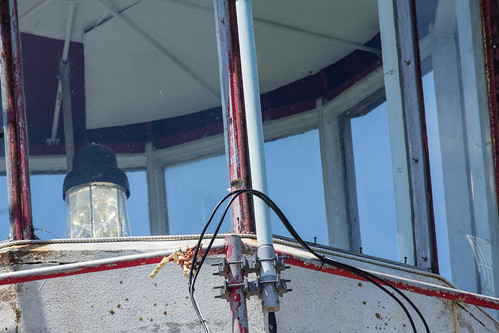 |
 |
Pigging out on berries brings the birds down to eye level for feeding, giving us wonderful photo ops. Some fruiting shrubs in the back of my yard gave me abundant opportunities to watch and photograph several this fall. It was when looking at some of these photos that I realized just how much my affection for these birds had ripened into true love.
But for me, loving Red-eyed Vireos meant that I started worrying about them. Migration is treacherous. Red-eyed Vireos are killed in large numbers at lighted tall structures such as high rises and communications towers, and even in the day they are one of the birds that often hit our house windows. The migration of Sharp-shinned Hawks and Merlins is fueled by tiny songbirds like Red-eyed Vireos. It's a jungle out there long before they hit the actual tropical jungles with snakes and poisonous insects and other new hazards.
Yet despite all the dangers, there have been two reports of banded Red-eyed Vireos surviving over 10 years in the wild. One first-year bird banded in Michigan in August 1997 was recaptured and released in Michigan in August 2007 when it was 10 years and 2 months old. An adult banded in Maryland in June 2003 was recaptured alive and released in May 2013. That bird was a minimum of 10 years 11 months, and because its age was unknown when it was first captured, could have been a year or more older than that. These birds that weigh just half an ounce had each traveled ten times—entirely on their own power, with no support teams or rooting fans, no back-up plan or judges to call the race if the weather turned bad, no medical support tents along the way—all the way from their home state to South America, and after wintering there, made the return journey another 10 times, yet were still going strong.
Few birds sing during the winter, including this persistent vocalist. During migration and on their wintering grounds, Red-eyed Vireos give their whiny call, but apparently don't start singing in spring until they reach Gulf Coast barrier islands. Soon they'll be on their home territories again, singing tens of thousands of songs each day in their endless quest to ensure that this little planet has an endless supply of Red-eyed Vireos for those of us in the know to love or, in the case of a few sourpusses who resist their charms, to disparage.
Yet despite all the dangers, there have been two reports of banded Red-eyed Vireos surviving over 10 years in the wild. One first-year bird banded in Michigan in August 1997 was recaptured and released in Michigan in August 2007 when it was 10 years and 2 months old. An adult banded in Maryland in June 2003 was recaptured alive and released in May 2013. That bird was a minimum of 10 years 11 months, and because its age was unknown when it was first captured, could have been a year or more older than that. These birds that weigh just half an ounce had each traveled ten times—entirely on their own power, with no support teams or rooting fans, no back-up plan or judges to call the race if the weather turned bad, no medical support tents along the way—all the way from their home state to South America, and after wintering there, made the return journey another 10 times, yet were still going strong.
Few birds sing during the winter, including this persistent vocalist. During migration and on their wintering grounds, Red-eyed Vireos give their whiny call, but apparently don't start singing in spring until they reach Gulf Coast barrier islands. Soon they'll be on their home territories again, singing tens of thousands of songs each day in their endless quest to ensure that this little planet has an endless supply of Red-eyed Vireos for those of us in the know to love or, in the case of a few sourpusses who resist their charms, to disparage.
